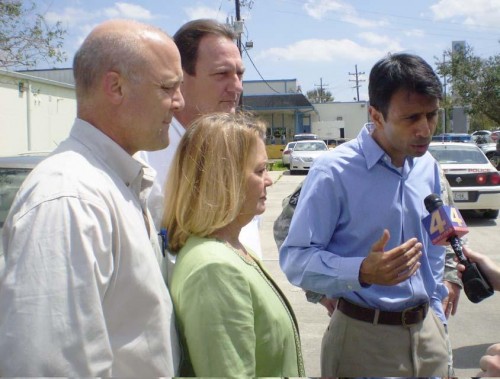
Lafourche Parish shows signs of slow return to normalcy
September 16, 2008Southdown Plantation House/The Terrebonne Museum (Houma)
September 18, 2008While state and federal leaders received mainly rave reviews for the response to Hurricane Gustav, not everything went off without a hitch.
The storm exposed some continuing shortages and problems in Louisiana’s disaster response efforts.
Shelters in north Louisiana didn’t offer showers to evacuees for days or enough bathrooms, food and water ran low at supply sites for the hundreds of thousands without power, and a disaster food stamp program set up to help feed families became overwhelmed by the crush of applicants.
Gov. Bobby Jindal could point a finger about supply shortages at the Federal Emergency Management Agency, deemed one of the dismal failures in response to Hurricane Katrina in 2005. But several of the problems that emerged after Gustav fall squarely on the shoulders of Louisiana officials.
In Gustav’s aftermath, Jindal and other state leaders agreed Louisiana must tweak its preparedness plans.
When evacuations for Gustav began, some of the state shelters set up in north Louisiana simply weren’t prepared for evacuees. Shelters in Bastrop, Monroe and Shreveport didn’t offer portable shower facilities for three days, and too few bathrooms were available.
The private contractor hired by the state to ready the shelters said it didn’t get enough lead time before the storm and only received the purchase order for showers from the Department of Social Services on the day Gustav struck. Social Services Secretary Ann Williamson said delivery of the showers took longer than expected.
Jindal called shelters an “area where again the plan was not executed appropriately, properly and that has to be looked at.” Williamson said her department is considering whether the state should set up a more long-term shelter site in north Louisiana that wouldn’t require portable showers and toilets to be trucked in.
Once people started pouring out of shelters and heading back home, they faced new problems. Lack of power left more than 1 million homes and businesses in the un-airconditioned dark, and the state sites set up to provide meals-ready-to-eat, water and ice for those without power ran low on supplies.
The distribution sites run by the Louisiana National Guard quickly doled out the food and water pre-positioned by the state, and FEMA supply trucks stocked with millions of MREs and water bottles were slower than promised to arrive.
FEMA officials said the state burned through supplies much faster than anticipated.
“We were told to push out our supplies, with the guarantee that FEMA would replenish those supplies immediately, and when that didn’t happen because of logistical problems, that’s what began to cause some of these shortages,” Jindal said.
For future storms, Jindal said the state will preposition even more supplies, but he also noted it wouldn’t be practical for Louisiana to stockpile millions of MREs with expiration dates and it wouldn’t be possible to stockpile millions of pounds of ice. That leaves Louisiana dependent in many ways on FEMA’s ability to offer food and water.
Just as the demand on distribution sites began to ease, new problems erupted, this time with the disaster food stamp program.
The program began understaffed and apparently unprepared for the crush of people seeking help. Thousands of people waited in hours-long lines for food stamps in several parishes on the opening day of the program, also run by the social services department. In many instances, people waited for hours only to be sent home without help.
“Our people, after going through a storm, they certainly shouldn’t have to go through that as part of a recovery process. That’s certainly not acceptable,” Jindal said.
Williamson brought on more staff, extended application site hours and got the wait time down to less than half an hour in most instances by the next few days of the program, but only after blistering criticism from the governor and from frustrated applicants.
Now, storm-weary Louisiana residents wait to see if more problems will crop up after Gustav – and whether the latest round of disaster response snafus that emerged this hurricane season will be fixed by the next round of storms.
EDITOR’S NOTE: Melinda Deslatte covers the state Capitol for The Associated Press.








